Reproduction in Animals Class 8 Notes Science Chapter 6
Animals have a special way of making more of their kind to ensure life continues. This process is called reproduction, and it's what separates living things from non-living things. Reproduction is how animals create new individuals like themselves.
Modes of Reproduction
Reproduction can occur through two primary modes: sexual and asexual reproduction.
Sexual Reproduction
- Sexual reproduction requires two parents.
- Males and females have distinct reproductive organs.
- These organs produce male and female gametes, which combine to form offspring.
- Genetic information from both parents is inherited.
- Humans are an example of sexual reproduction.
Sexual Reproduction in Humans
Sexual reproduction in humans involves the fusion of male and female gametes to create offspring. Sperm, produced by the male reproductive system, combines with the ovum, or egg, produced by the female reproductive system.
Male Reproductive System
The male reproductive system comprises testes, sperm ducts, and a penis. The testes are located externally and are responsible for producing sperm, the male gametes.
 Male Reproductive System
Male Reproductive System
Testosterone:
- Testosterone, the primary male sex hormone, is synthesized in the testes.
- It plays a crucial role in the development of sex organs, sperm production, and the emergence of secondary sexual characteristics.
Sperms:
- Sperm, the male gametes, are generated in large quantities by the testes.
- Each sperm is a microscopic cell with distinct parts: a head, a middle piece, and a tail.
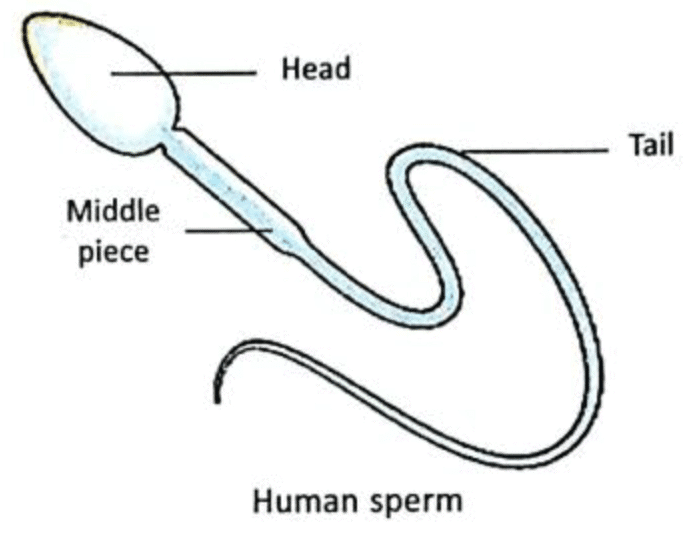
- The head contains a nucleus with a single set of chromosomes, while the middle piece contains numerous mitochondria that provide energy for the sperm's motility.
- With the help of its tail, the sperm is a mobile gamete that moves through the female reproductive tract.
Female Reproductive System
The female reproductive system consists of ovaries, fallopian tubes(oviducts), and a uterus. The ovaries produce ova, the female gametes.
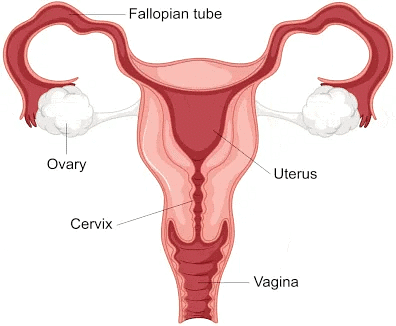 Female Reproductive System
Female Reproductive System
Oestrogen:
- Oestrogen, also known as estrogen, is the primary female sex hormone secreted by the ovaries.
- It plays a vital role in the development of female reproductive organs, secondary sexual characteristics, ovum development, and the regulation of the menstrual cycle.
Ova:
- Ova, or eggs, are the female gametes produced by the ovaries.
- In humans, a single mature ovum is released into the fallopian tube every month.
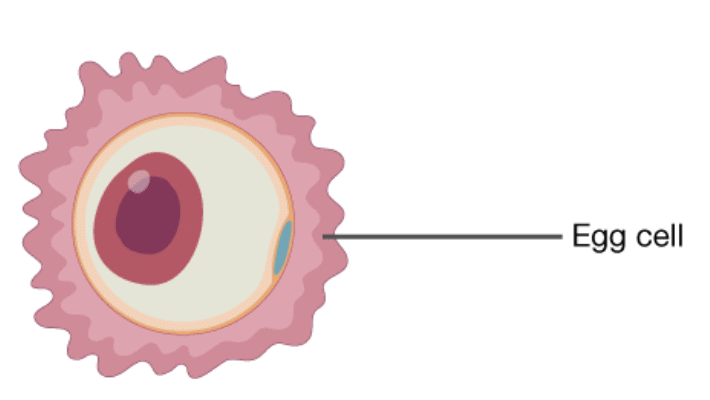
- The ovum is a larger, non-motile cell compared to sperm.
- It travels through the oviduct to reach the uterus.
Fertilization
Fertilization occurs when the male gamete (sperm) fuses with the female gamete (ovum). This fusion results in formation of zygote.
Fertilization typically takes place in the fallopian tube, after which the zygote is transported to the uterus. Within the uterus, the zygote undergoes repeated divisions and develops into an embryo.
Two types of Fertilization
(a) Internal Fertilization:Internal fertilization occurs inside thereproductive tract of the female organism.
- During internal fertilization, a male typically introduces sperm directly into the female's reproductive system. The sperm and egg unite within the female's body, usually in specialized reproductive structures.
- Examples:Mammals, includinghumans, birds, reptiles, and some insects, exhibit internal fertilization.
(b) External Fertilization:External fertilization takes placeoutside the body of the female, usually in an aquatic environment.
- In external fertilization, both male and female gametes are released into the external environment, such as water. The fusion of sperm and egg occurs externally, and the resulting zygote develops independently in the environment.
- Examples:Fish, amphibians (like frogs and toads), many invertebrates (such as starfish and sea urchins), and some plants utilize external fertilization.
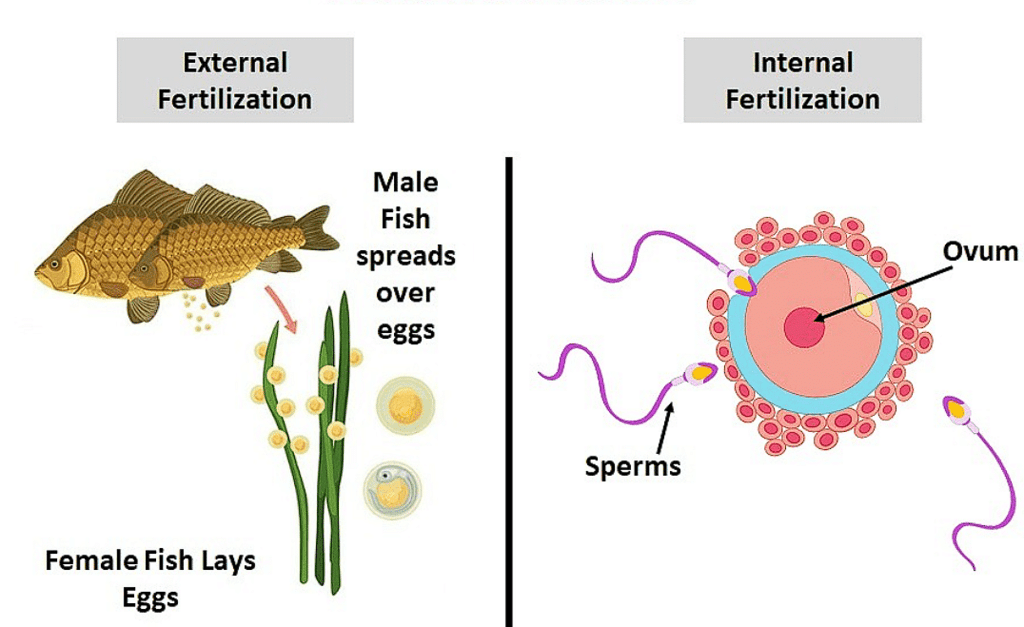 Types of Fertilization
Types of Fertilization
Development of Embryo
1. Fertilization and Embryonic Development in Humans
- Formation of the Zygote: Fertilization results in the formation of azygote.
- Cellular Division and Tissue Formation: Zygote divides, forming a ball of cells that developinto differenttissues and organs.This developing structure is called an embryo.
- Implantation in the Uterus: The embryoembeds in the uterine wall for further development.
- Fetal Development and Birth: The embryo develops body parts, becomes a fetus, and is eventually born.
2. Unique Hen Reproduction
- Internal Fertilization in Hens: Similar to humans, but hens don't give birth to babies.
- Protective Layers and Egg Formation: The zygote develops protective layers, resulting in the hard shell of an egg.
- Incubation and Chick Development: Hen sits on the eggs, providing warmth for about 3 weeks until the chick inside the egg is fully developed.
- Hatching Process: Chick bursts open the eggshell when fully developed.
3. External Fertilization in Animals
- Development Outside the Female Body: Embryo development occurs externally.
- Growth Within Egg Coverings: Embryos grow within protective egg coverings.
- Hatching of Eggs: After development, eggs hatch, revealing the newborn.
- Example: Tadpoles in Ponds: Tadpoles, as an example, undergo external fertilization, growing and hatching outside the female frog's body.
Viviparous and Oviparous Animals
Viviparous animals give birth to live young ones, while Oviparous animals lay eggs from which their offspring hatch.
1. Viviparous Animals
- Viviparous animals are those that give birth to live young ones directly. In these cases, the embryo develops within the mother's body, and the offspring are born alive.
- Examples: Dogs, cats, cows, and humans are common examples of viviparous animals.
2. Oviparous Animals
- Oviparous animals are those that lay eggs. The development of the embryo occurs outside the mother's body. The young ones hatch from these eggs.
- Examples:Birds (like hens and crows), reptiles (like frogs and lizards), and insects (like butterflies or moths) are examples of oviparous animals.

Young Ones to Adults
- After being born or hatched from eggs, young animals continue to grow until they become adults.
- In some animals, the young ones may look very different from the adults.
- The life cycle of a frog includes three distinct stages: egg, tadpole (larva), and adult.
- Tadpoles look different from adult frogs, but they undergo a transformation called metamorphosis.
- Metamorphosis is a process where the larva transforms into an adult through drastic changes.
 Life Cycle of a Frog
Life Cycle of a Frog
- Humans do not undergo metamorphosis like frogs. Body parts similar to those in adults are present from birth.
[Intext Question ]
Asexual Reproduction
- Asexual reproduction involves a single parent.
- There is no mixing of genetic information.
- For instance, Hydra reproduces through budding.
(a) Fission
Fission is an asexual reproductive mechanism in which a single-celled organism undergoes division, resulting in the formation of two separate cells.
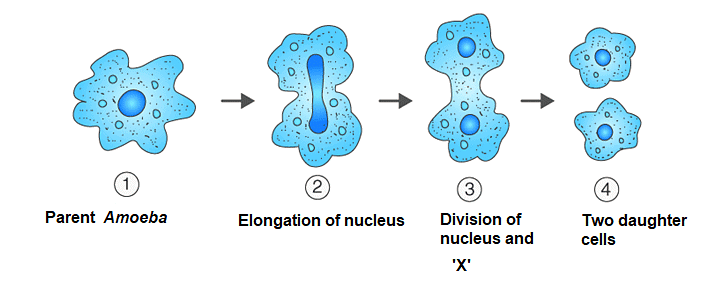 Fission in Amoeba
Fission in Amoeba
- During fission, the nucleus and other cellular structures divide, leading to the creation of two distinct cells.
- Amoeba, for instance, reproduces through a process called binary fission, where a single parent cell splits into two offspring cells.
- In some cases, fission can also give rise to multiple daughter cells from a single parent cell. This variant is known as multiple fission. It occurs when one parent cell produces numerous offspring cells.
(b) Budding
- Budding is a form of reproduction where a bud grows from the parent body and becomes a separate organism.
- Some organisms retain the buds attached to the parent's body (e.g., yeast), while others detach and develop independently (e.g., Hydra).

FAQs (Frequently Asked Questions)
1. What are the two main types of reproduction in animals?
Ans. The two main types of reproduction in animals are sexual and asexual reproduction. Sexual reproduction involves the fusion of gametes from two parents, while asexual reproduction involves the production of offspring from a single parent.
2. How do animals reproduce sexually?
Ans.In sexual reproduction, males produce sperm and females produce eggs. Fertilization occurs when a sperm cell meets an egg cell, forming a zygote. The zygote undergoes cell division and develops into an embryo, which eventually grows into a new individual.
3. What is the role of hormones in animal reproduction?
Ans. Hormones play a crucial role in animal reproduction by controlling the development and function of reproductive organs and regulating the production of gametes. They also stimulate behaviors necessary for reproduction, such as courtship and mating.
4. What is the difference between internal and external fertilization?
Ans. Internal fertilization occurs when sperm are deposited inside the female's body and fertilize the eggs there. This type of fertilization is found in most terrestrial animals and some aquatic animals. External fertilization occurs when eggs and sperm are released into the environment and fertilization occurs outside the body. This type of fertilization is found in many aquatic animals.
5. What are the advantages and disadvantages of asexual reproduction?
Ans.Asexual reproduction has the advantage of producing offspring quickly and efficiently without the need for a mate. However, it can lead to low genetic diversity and make populations more vulnerable to disease or environmental changes. Additionally, asexual reproduction does not allow for the mixing of genetic material between individuals, which can limit the potential for adaptation and evolution.
|
92 videos|296 docs|44 tests
|






















